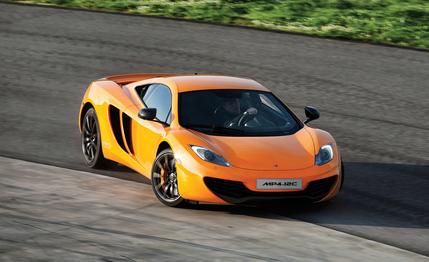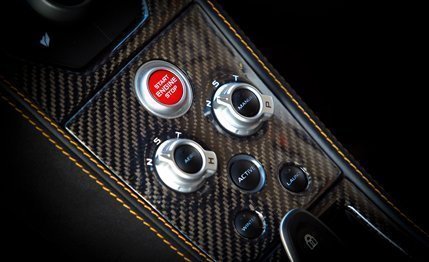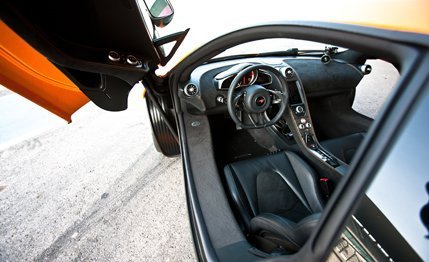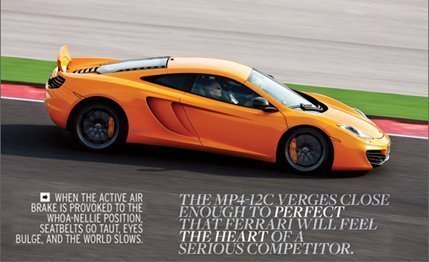
 First Drive Review
First Drive Review
The McLaren MP4-12C needed only 100 yards to make clear that it won’t play by Enzo’s supercar rules. Pain is not part of the deal. Bumps don’t jangle its nerves. The engine and transmission do their business without a fuss. We expected the MP4 to be quick and track-hungry, but the baby-carriage ride we noted with the “normal” chassis mode—engaged for the scarred and tarred paths in Mexilhoeira Grande, Portugal, where McLaren presented the fruits of its seven-year labor—rang our “holy cow!” bell.
You spring open the MP4’s dramatic insect-wing door by sweeping a hand along a flush surface tucked under the side scoop’s upper edge. Leading with your right leg followed by a dab of body English, it’s an easy glide into the nicely bolstered seat. There’s a huge 9000-rpm tach and a steering wheel unburdened by switchgear, with a center-pivoting shift paddle. The leather and faux suede are sewn to Savile Row standards.

 Logic reigns in the MP4-12C's office. Two rotating knobs adjust handling and powertrain parameters in normal, sport, and track modes. Coaxial buttons activate the rear wing and enable manual shifting.
Logic reigns in the MP4-12C's office. Two rotating knobs adjust handling and powertrain parameters in normal, sport, and track modes. Coaxial buttons activate the rear wing and enable manual shifting.
The most impressive part of the cockpit is the intelligently arranged center console. There’s a big red button to fire the engine, one knob to set handling parameters, a second knob to adjust powertrain behavior, and five logically positioned single-function buttons. The less critical controls are positioned out of the action zone on column stalks, along the armrests, and on the dash below the instrument cluster.
Punching the hot button with the brake pedal depressed cues genteel whirring sounds behind your shoulders. Blipping the throttle in neutral conjures no Formula 1 starting-grid fantasies. This V-8 is soft-spoken, polite to a fault. Its initial impression is unimpressive. And with no clutch pedal or shift lever to play with, there’s risk of Lexus-like sensory deprivation setting in.
Tugging the right side of the shift paddle engages first gear. The dual-clutch box delivers such a clunk- and chug-free roll-off, you’d swear there’s a torque converter at work here. Under light throttle, automatic upshifts are smoothly and swiftly executed. Before you realize it, the digital gear indicator has counted up to six and you’re rolling along at highway velocity with minimal enthusiasm from the tach needle or the engine room. The MP4’s unspoken mantra is speed without the spectacle.
Fortunately, politeness is just one aspect of the MP4’s psyche. The “normal” drive mode—the pride of the development team and as heretical to the supercar cult as the Lamborghini Miura’s mid-engine move was 45 years ago—is merely the appetizer to McLaren’s feast. So, after paying our respects at normal, we moved on through the sport and track settings to liberate the MP4’s mischievous twin.
With a 4000-rpm spread between torque and horsepower peaks and 17.4 psi of boost on tap, the MP4’s 3.8-liter engine feels more like a strapping V-10 than a mini V-8. There’s no hint of turbo lag or, for that matter, any evidence that this engine is turbocharged except for an occasional waste-gate chortle during shifts. The torque curve is as flat as an electric motor’s.

 A single pivoting shift paddle moves with the leather- and carbon-fiber-trimmed steering wheel.
A single pivoting shift paddle moves with the leather- and carbon-fiber-trimmed steering wheel.
Lock the throttles open long enough to visit the top half of the rpm range, and three things happen: The intake plenum is jammed with excess air, a valve inside that box switches to a racier setting, and gentility is blown out the pipes. Without rivaling the shriek of a Ferrari V-8 or the gusto of a Lamborghini V-10, the MP4 rouses the hoofbeat of 593 horses keen on crashing the corral gate.
McLaren’s math says that the MP4’s broad torque curve and 5.4 pounds per horsepower will trounce Ferrari’s 458 Italia on the run to 60 mph (in three seconds flat) and through the quarter-mile (less than 11 seconds). We’ll check that prediction in the inevitable fight-to-the-death comparison test, but for now our drive was limited to a few blasts to 150 mph on the auto-estrada and a dozen or so chaperoned laps around the curve-crammed, 2.9-mile Autódromo Internacional do Algarve.
The MP4 checks the crucial speediness and joy-ride boxes. It’s quick and decisive when whipped and clever enough to flatter its driver. Turn-in is crisp, and the cornering attitude is readily adjustable. If you charge a bend with excess speed, the MP4 automatically dabs its inside rear brake to mitigate the understeer you provoked. Add throttle prematurely exiting a turn, and the tail will step wide but never in a threatening manner because the stability-control system engages unobtrusively to save the day. Amateurs will enjoy this ride, good drivers will feel like track stars, and great pilots will find the MP4 a handy tool for polishing their skills. There’s something here for everybody.
The MP4 has two special weapons found in no other supercar. Its hydraulic suspension so inhibits body roll that it handles tight jinks with a go-kart’s agility. And the rear airfoil, which springs to attention during hard braking, adds yards to every straightaway.
The MP4 has the moves of a master and the brains of a child prodigy. It verges close enough to perfect that Ferrari will feel the heat of a serious competitor while other supercar makers will struggle to match this combination of value, performance, and technological intrigue.
Of course, there are lapses. The MP4 suffers from an obvious lack of sex appeal, and it was christened with a part number instead of an evocative name. We wouldn’t mind a touch more steering feel and less brake-pedal travel during aggressive stops. High-speed stability is slightly shaky, a fault probably attributable to the substantial aero forces heaving on the rear of the car. Lower seat bolsters are spread to accommodate thunder thighs, a flaw easily resolved by ordering the optional sport seats. A lighter, louder sport exhaust system is also coming. Lastly, the MP4 could use a nicer welcome mat than the mouse fur covering the doorsills.


However, the MP4 earns A’s for inspiration and execution. Early adopters have dibs on the 300 or so cars planned for U.S. delivery this year (beginning in August), but they’ll be followed by 1000 or more cars in 2012. And where the MP4 goes, other McLarens will follow. Count on a convertible, a less-expensive model, and a successor to the legendary McLaren F1 before the clock strikes 2016.
If there’s a ray of sunshine beaming down on a usually gloomy Great Britain, it may be Bruce McLaren smiling over what his successors have achieved.